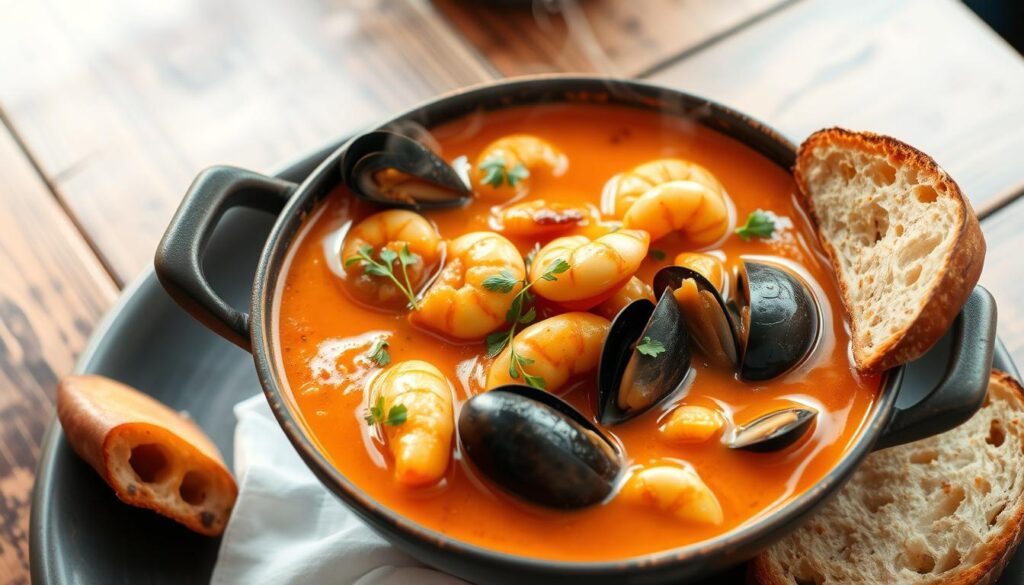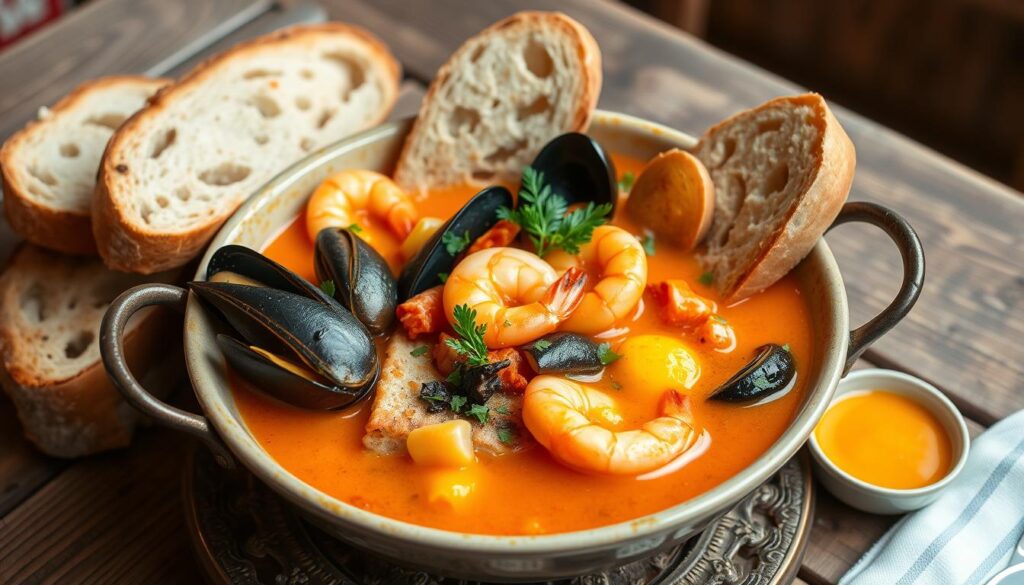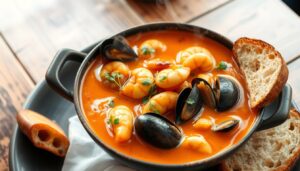
To truly enjoy bouillabaisse, you need to know how to say it right. It’s often tricky for those who don’t speak French. Once you get it, you’ll love the dish even more. And learning to make it is a fantastic way to start cooking.

Table of Contents
Making bouillabaisse is more than just a recipe. It’s about the rich culture behind this French stew. By learning the right way to say it and its history, you’ll make a dish that will wow everyone. Soon, making bouillabaisse will feel like second nature.
Key Takeaways
- Mastering the correct bouillabaisse pronunciation is essential to appreciating the dish
- Learning how to make bouillabaisse requires understanding its cultural heritage
- Bouillabaisse is a traditional French stew originating from Marseille
- Understanding the correct bouillabaisse pronunciation will enhance your culinary experience
- How to make bouillabaisse is a skill that requires practice and patience
- Authentic bouillabaisse recipes are essential to creating a delicious and traditional dish
The Cultural Heritage of Bouillabaisse France
Bouillabaisse, a traditional French stew, has a rich history. It’s important to know its origins and how it has changed. The pronunciation of bouillabaisse might be hard for some, but learning it helps us connect with its culture.
In Marseille, bouillabaisse pronounce brings to mind community and tradition. It started as a way for fishermen’s wives to use leftover fish and veggies. Now, Bouillabaisse is a famous dish with many variations across France.
Origins in Marseille’s Fishing Community
Marseille’s fishing community has shaped Bouillabaisse’s culture. The dish is a big part of the city’s identity. Many restaurants in Marseille offer their own special versions.
Evolution from Humble Dish to Culinary Icon
Bouillabaisse’s popularity led to a big change. It went from a simple dish to a culinary star. New ingredients and cooking methods made it even better.
Regional Variations Across France
Bouillabaisse is not just from Marseille; it’s enjoyed all over France. Each region has its own twist, showing off French diversity. This makes Bouillabaisse a true reflection of French culture.
Understanding Bouillabaisse’s cultural background helps us see its importance in French food. Whether you love food or just want to try something new, Bouillabaisse is a must-try. It will surely leave you craving for more.
Mastering Bouillabaisse Pronunciation
To fully enjoy bouillabaisse, learning how to say it right is key. The correct bouillabaisse pronunciation is “boo-yah-bess.” Emphasize the second syllable. This will make you more confident when you order it or cook it for others.
Knowing how to say bouillabaisse can also make your dining experience better. Here are some tips to help you get it right:
- Listen to native French speakers say the word to learn the right tone and stress.
- Practice saying the word a few times to improve your confidence and fluency.
- Pay attention to the second syllable, “yah,” which is where the stress is in the bouillabaisse pronunciation.
Mastering the bouillabaisse pronunciation lets you appreciate the dish more. It connects you to its rich cultural background. Whether you love food, French culture, or just great meals, saying bouillabaisse correctly is a big part of enjoying it.
Essential Ingredients for Traditional Bouillabaisse
To make authentic bouillabaisse, using traditional ingredients is key. Each part of the dish is important. It includes fresh seafood like mussels, clams, and shrimp.
Aromatics like onions, garlic, and fennel add depth and flavor. Saffron, a pricey spice, gives the dish its yellow color and subtle earthy taste. Together, these ingredients make a rich, flavorful broth.
Required Fresh Seafood Types
Fresh seafood is crucial for bouillabaisse. Common seafood types include:
- Mussels
- Clams
- Shrimp
- Scallops
Aromatics and Herbs
Aromatics and herbs also play a big role in bouillabaisse’s flavor. Common ones are:
- Onions
- Garlic
- Fennel
- Thyme
The Significance of Saffron
Saffron is vital in traditional bouillabaisse. It adds a yellow color and a subtle earthy flavor. Learning how to use saffron is essential when making bouillabaisse.
Understanding the Classic Rouille Sauce
Rouille sauce is a traditional Provençal condiment often served with Bouillabaisse. Knowing how to say rouille pronunciation, which is “roo-ee,” can make you appreciate this sauce more. The right way to say rouille pronunciation is key to understanding its cultural value.
To make the rouille sauce, you blend garlic, saffron, and chili peppers with olive oil and bread. This creates a smooth, flavorful paste. First, roast the garlic and chili peppers. Then, mix them with the other ingredients. This sauce is essential for Bouillabaisse, adding a rich flavor from its carefully chosen ingredients.
Traditional Ingredients
- Garlic
- Saffron
- Chili peppers
- Olive oil
- Bread
Using these ingredients, along with the correct rouille pronunciation, offers a real taste of authenticity. Knowing the traditional ingredients and how to make the sauce helps you see its cultural importance. It’s a key part of the famous Bouillabaisse dish.
Preparation Techniques
Making the rouille sauce involves roasting garlic and chili peppers, then blending them with other ingredients. This method needs careful attention and the use of fresh, quality ingredients. By sticking to these traditional steps, you can make a true rouille sauce that enhances the Bouillabaisse’s rich flavors.
| Ingredient | Quantity | Preparation |
|---|---|---|
| Garlic | 3 cloves | Roasted |
| Saffron | 1/2 teaspoon | Soaked in hot water |
| Chili peppers | 2 peppers | Roasted |
Selecting and Preparing Your Seafood
Choosing the right seafood is key to making a true bouillabaisse. You’ll need fresh fish and shellfish like mussels, clams, and shrimp. These are must-haves for a classic bouillabaisse experience.
To get ready, clean and cut the fish into small pieces. Also, remove the shells from the shellfish.
Here are some tips for picking the best seafood:
- Freshness: Pick the freshest seafood for the best taste and texture.
- Variety: Use a mix of fish and shellfish for a rich, complex broth.
- Sustainability: Choose sustainable seafood to help the environment.
By carefully choosing and preparing your seafood, you’ll make a delicious, authentic bouillabaisse. It will highlight the Mediterranean’s flavors.
The Art of Creating the Perfect Fish Stock
To make a real bouillabaisse broth, you need a rich fish stock. This is made by mixing fish bones, veggies, and aromatics. Then, you simmer them to get all the flavors out.
Making the perfect fish stock takes patience and care. Proper simmering techniques are key. They help get the flavors without making the stock bitter. You must watch the simmering time and temperature closely to get it just right.
Key Ingredients for the Base
The base of the fish stock includes:
- Fish bones and heads
- Vegetables like onions, carrots, and celery
- Aromatics such as garlic and bay leaves
Proper Simmering Techniques
The way you simmer is very important for a great fish stock. You should simmer gently, not boil, to get the flavors right. The simmering time varies, but it’s usually between 30 minutes and a few hours.
Step-by-Step to how to Make Authentic Bouillabaisse
Cooking bouillabaisse is a detailed and patient process. It starts with preparing the seafood and aromatics. Then, you make the fish stock and Rouille sauce. First, get all the ingredients for the bouillabaisse recipe. This includes fish, shellfish, veggies, and spices.
To make the fish stock, simmer fish bones and veggies in water. This extracts the flavors. While that cooks, make the Rouille sauce. It’s a Provençal condiment with olive oil, garlic, and saffron. Once both are ready, add the seafood, aromatics, Rouille sauce, and seasonings to the stock.
- Bring the stock to a gentle boil, then reduce the heat to a simmer.
- Add the seafood and aromatics to the stock, making sure they are fully submerged.
- Let the bouillabaisse recipe simmer for at least 20-30 minutes, allowing the flavors to meld together.
- Season with salt, pepper, and other herbs to taste.
By following this cooking bouillabaisse guide, you’ll make a delicious and authentic dish. It will surely impress your family and friends.
Traditional Serving Methods and Presentation
Serving bouillabaisse is all about the presentation. It’s served in a large, shallow bowl. This lets the flavors and aromas mix well. The right bowl is key to enjoying the dish fully.
The way you layer the ingredients is also important. You want a mix of colors and textures. Include fresh seafood, vegetables, and aromatics like saffron and fennel.
- Fresh seafood, such as mussels and clams
- Vegetables, like onions and tomatoes
- Aromatics, including saffron and fennel
To make it look fancy, add saffron and Rouille sauce. It boosts the flavor and looks great. This way, your bouillabaisse will impress everyone.

Pay attention to the details when serving bouillabaisse. It makes this classic French stew even better. Whether it’s for a dinner party or a casual get-together, a beautifully presented bouillabaisse will be a hit. So, focus on your presentation and amaze your guests with this tasty and beautiful dish.
Wine Pairing Suggestions
When it comes to wine pairing, Bouillabaisse is a dish that offers a unique opportunity to explore various options. The key is to find a wine that complements the rich flavors of the stew without overpowering them. For a classic wine pairing experience, consider a dry and crisp white wine like Sauvignon Blanc or Rosé. These wines can cut through the richness of the Bouillabaisse, creating a beautiful balance of flavors.
A light and fruity red wine like Pinot Noir can also pair well with Bouillabaisse, especially if it’s served with a variety of seafood. The delicate flavors of the fish and the subtle sweetness of the wine create a harmonious combination. When selecting a bouillabaisse wine, consider the specific ingredients used in the recipe and the overall flavor profile of the dish.
Some popular wine pairing options for Bouillabaisse include:
- Sauvignon Blanc
- Rosé
- Pinot Noir
These wines offer a range of flavor profiles that can complement the complex flavors of the Bouillabaisse. Ultimately, the choice ofbouillabaisse winewill depend on personal preference and the specific ingredients used in the recipe.
By considering the unique flavor profile of Bouillabaisse and selecting a wine that complements its rich flavors, you can create a truly unforgettable wine pairing experience. Whether you prefer a crisp white wine or a light red wine, there’s a bouillabaisse wine out there that’s sure to enhance your enjoyment of this classic dish.
| Wine | Flavor Profile | Pairing Suggestions |
|---|---|---|
| Sauvignon Blanc | Crisp and refreshing | Seafood, particularly fish and shellfish |
| Rosé | Light and fruity | Seafood, particularly fish and shellfish |
| Pinot Noir | Delicate and subtle | Seafood, particularly fish and shellfish |
Common Mistakes to Avoid
When making bouillabaisse, knowing common mistakes is key. These mistakes can change the dish’s flavor and texture. To avoid them, focus on the right ingredients, cooking temperature, and timing. Using low-quality seafood or aromatics can ruin the dish.
Some common errors include:
- Choosing the wrong ingredients, like low-quality seafood or aromatics
- Not controlling the cooking temperature well
- Not cooking the seafood long enough or too long
To make a great French stew, pay attention to these mistakes. Attention to detail is vital. With practice, you can avoid these errors and make a delicious bouillabaisse.
For a successful bouillabaisse, balance flavors and textures. Avoid mistakes that can spoil the dish. Follow these tips and be careful with cooking errors to make a memorable bouillabaisse.
Modern Adaptations While Maintaining Authenticity
Modern bouillabaisse has evolved, keeping its traditional essence. Chefs and home cooks can use sustainable seafood like local fish and shellfish. This adds new flavors and aromas to the stew.
Some chefs add saffron or paprika for a unique twist. Others try different fish or shellfish, like mussels or clams. This makes the broth more diverse and flavorful.
Here are some ways to modernize your bouillabaisse while keeping it true to its roots:
- Use fresh, locally sourced ingredients for the best flavors and textures.
- Try different spices and seasonings to give the dish a unique flavor.
- Choose sustainable seafood to reduce your environmental impact.
By adding these modern touches to your bouillabaisse, you can make a dish that’s both traditional and new. It will have a unique flavor and style that’s yours. Whether you’re a pro chef or a home cook, bouillabaisse is a dish that’s full of possibilities for creativity and fun.
| Ingredient | Traditional | Modern |
|---|---|---|
| Fish | Cod, haddock | Sustainable cod, haddock |
| Shellfish | Mussels, clams | Locally sourced mussels, clams |
| Spices | Saffron, thyme | Saffron, thyme, paprika |
Conclusion
Bouillabaisse, a dish from Marseille, has won the hearts of food lovers everywhere. It started in fishing communities and now is a prized dish. It has changed over time but kept its true spirit.
By using traditional methods and ingredients, anyone can make a delicious bouillabaisse. This dish is a key part of French cuisine. It brings joy to those who taste it.
Whether you’re new to bouillabaisse or have made it many times, it’s a rewarding experience. It’s a mix of culture, creativity, and the joy of cooking. Each spoonful takes you to the coast where it was born.
By keeping the traditions alive and adding your own twist, you carry on the bouillabaisse legacy. This way, the dish’s spirit will continue to delight people for many years.
FAQ of How to Make Authentic Bouillabaisse
What is the correct pronunciation of Bouillabaisse?
Bouillabaisse is pronounced as “boo-yah-bess.” The emphasis is on the second syllable.
What is the pronunciation of Rouille sauce?
Rouille is pronounced as “roo-ee.”
What is the proper way to serve Bouillabaisse?
Serve Bouillabaisse in a large, shallow bowl. This lets the flavors mix well.
Layer the seafood and vegetables carefully for a nice look. Add saffron and Rouille sauce for elegance.
What are the essential ingredients for traditional Bouillabaisse?
Traditional Bouillabaisse needs fresh seafood like mussels, clams, and shrimp. Onions, garlic, and fennel are also key. Saffron gives it a yellow color and a unique flavor.
What are some common mistakes to avoid when making Bouillabaisse?
Avoid using low-quality seafood and aromatics. Don’t mess with the cooking temperature or timing. Overcooking or undercooking the seafood is a big no-no.
Can Bouillabaisse be adapted with modern ingredients while maintaining authenticity?
Yes, Bouillabaisse can get a modern twist. Chefs and home cooks can try new ingredients and methods. This keeps the dish true to its roots, like using sustainable seafood or adding spice.
French fish stew, also known as bouillabaisse, is a traditional Provençal dish made with a variety of fresh fish, shellfish, and aromatic herbs simmered in a flavorful broth. It’s a hearty and delicious seafood classic from the South of France.
Bouillabaisse recipe . .Bouillabaisse pronunciation
.Traditional bouillabaisse recipe
.Easy Bouillabaisse recipe .Bouillabaisse recipe
